 The dry wash described below lets out into this small cove on the lee side of the point.
The dry wash described below lets out into this small cove on the lee side of the point.
“Where you off to?” she asked.
“I saw a big crack in the Earth just down the road that looks like it needs to be explored,” I said.
 Looking over the dry wash from above. Shortly beyond the last visible trees the canyon narrows into a gorge.
Looking over the dry wash from above. Shortly beyond the last visible trees the canyon narrows into a gorge.
We had just returned from a six hour road trip and I desperately needed to get out. This dog needed to be released from the kennel and unleashed for a run.
One might question how a six hour drive could possibly be called a road trip. It’s a fair question. I have a good reason.
Spend five hours locked in the van with two four year olds and a seven year old with nothing to do, with but an hour break for lunch, and you’d call it a trip, too.
I drink little and infrequently, and rarely ever order a cocktail let alone in early afternoon and never with lunch, but this day I ordered one. “Oh wait,” I said as the waitress started to walk away. “I need some liquor.”
Suffice to say our day hadn’t gone according to plan due to approaching tropical storm, Darby. We essentially drove for six hours to eat lunch. We never made it to Volcanoes National Park. Damn right I was ordering a drink!
Fortunately the Mai Tai had hit like a mule kick and took me out of commission. Yeah, I know, I’m a real lightweight. Leveled by a single drink. My only defense is to say that it was stiffer than the British upper lip in WWII.
The drink helped to relax and soothe my frayed nerves, but also resulted in the Mrs. taking over driving duty. This in turn gave me the opportunity to gaze out the window, that had then resulted in my having spied that aforementioned big crack in the ground.
 The ragged and rugged scene while hiking up the canyon.
The ragged and rugged scene while hiking up the canyon.
That crack was really a chasm that had been carved deep into the lava rock by heavy rains that fall high up on the slope of Kohala (5,505′). Passing over a short bridge at speed, I had caught a glimpse of this small red-walled canyon filled with the green canopy of kiawe trees (Hawaiian mesquite). It winds its way up the slope of surrounding desert-like dry rolling grassland and narrows to a gorge. It looked too appetizing to be left alone. “No way,” I muttered to myself. “Wow.” I was compelled to go.
I stepped cautiously in my flip-flops down into the wickedly spiny forest of kiawe filling the canyon and had walked about forty yards up the dry creek bed from the beach when I saw it.
 The ruins were hard to capture clearly in a photo, but look carefully and the circular shape of a stacked stone design should be visible.
The ruins were hard to capture clearly in a photo, but look carefully and the circular shape of a stacked stone design should be visible.
There on a bench beside the wash, above flood level, was a large circular-shaped group of boulders. It resembled an old stacked stone wall enclosing an open space within where a patch of grass grew and it stood about three to four feet tall.
There was no question in my mind when I saw it that it was something of archaelogical significance, though it should be noted that I am not a trained expert and nor do I have confirmation by an expert. But what else could it be?
Many if not most of the boulders were too heavy for one man to lift and would require at least two or more people to move and arrange. It was not the sort of creation I would imagine modern people to have built for it clearly required a great deal of strenuous work and many hours. It was not some beach hut thrown together by modern locals at their favorite spot to hang out at.
 Looking at same ruin from another angle.
Looking at same ruin from another angle.
 A closer view of the stacked stones.
A closer view of the stacked stones.
 Looking out the mouth of the dry wash to the ocean.
Looking out the mouth of the dry wash to the ocean.
The site seemed well-suited for a camp. It was tucked back in the narrow canyon away from the immediate seashore and was sheltered from wind by forty to fifty foot sheer cliffs on either side. The mouth of the dry wash drained into the sea on the lee side of a small point and was protected from the prevailing winds. The location allowed for quick and easy access to the ocean for fishing or whatnot.
In the preceding days I had been freediving in the area nearby popping scallops from the rocks. My brother-in-law, a native Pacific Islander born on Hawaii, had introduced me to his friend who had shown me a photo of a thirty-five pound ulua he had recently shot nearby while spear fishing. They had told me of a man having disappeared last year while spear fishing not too far away, presumably due to a shark attack (link to story here). They told me about another guy who, four days later, survived a tiger shark attack while spear fishing in the same area (link to story here). I had also been told that in winter humpback whales pass by this place hardly more than a stone’s throw from the beach. Not that anybody needs one line anecdotes to appreciate that these coastal waters of Hawaii were (are) exceptionally rich, but this area probably wouldn’t have been a poor choice to camp in prehistoric times.
 Twelve hours later the formerly dry wash was raging, the eerie thud and crack of boulders being swept to sea, which is just visible here through the trees frame left.
Twelve hours later the formerly dry wash was raging, the eerie thud and crack of boulders being swept to sea, which is just visible here through the trees frame left.
The wash, while relatively small, was one of the more significant drainages in the area; a fact that was confirmed early the next morning when, after a night of heavy rain on the mountain, the formerly dry creek bed was a torrent of runoff that pushed a fluvial discharge of muddy water far out into the sea for several hundred yards.
No other such plumes of runoff could be seen along the coast anywhere in the immediate area. It was remarkable enough that it even caught the eye of my four year old son who pointed it out. Two days later the wash was empty again but, standing on the edge of the canyon high above, I could see a few pools of water dotting the otherwise dry creek bed. The silt had settled and the pools were clear; plenty of water to slake the thirst of the ancient ones who may have lived there.
 One of the other ruins, which appears far more distinct when standing before it than it looks in this photo, but the circular shape should be evident.
One of the other ruins, which appears far more distinct when standing before it than it looks in this photo, but the circular shape should be evident.
After spotting that first circular stand of boulders I began scanning the area more closely than I had previously, and out of the jumbles of lava rocks I began to notice several ruins of other lesser structures of similar form. I had overlooked them previously, but now they began to standout.
The ruins were grouped in the same area and all constructed from large and heavy boulders that would require group effort to move and arrange. It was plainly evident that a considerable investment of time and energy went into putting them together; not something I’d imagine modern people to have any interest in troubling themselves with.
Who else would bother with such hard work for so long as it took, but prehistoric people seeking to secure shelter and comfort from the elements along a coast naturally rich in sustenance?
Of course, supposing the ruins were indeed constructed long ago, they could be something other than the remains of prehistoric camp shelters. What might the purpose have been?
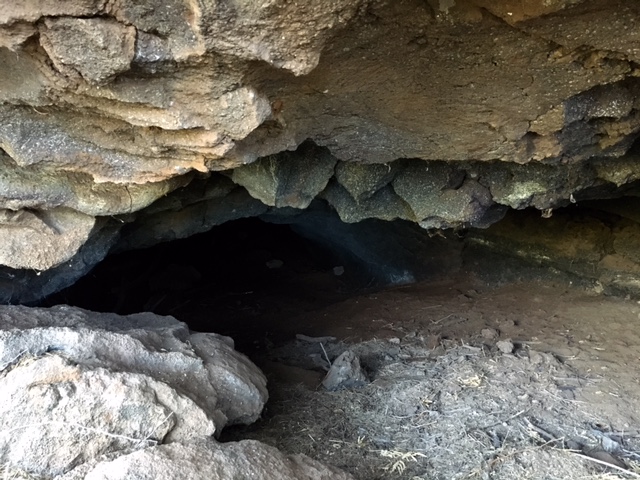 A cave about thirty-five feet above the dry wash on the cliff adjacent the ruins.
A cave about thirty-five feet above the dry wash on the cliff adjacent the ruins.






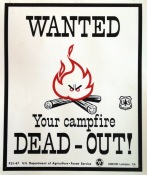

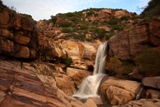
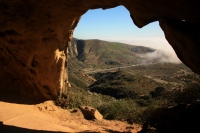

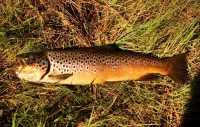
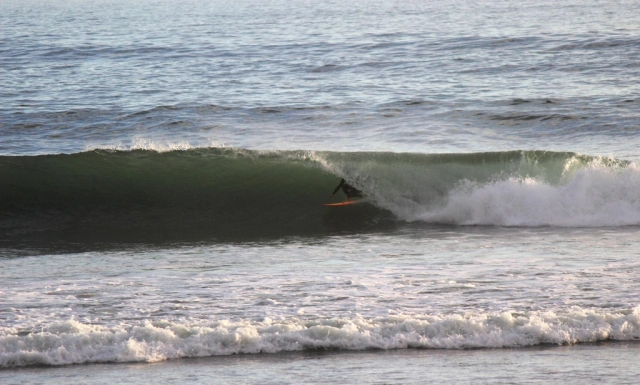
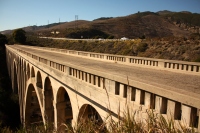
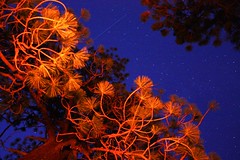








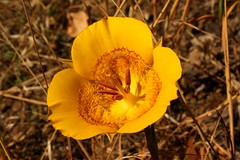









Epic! I’m womanamow’s husband, loved this adventure! thanks…
That’s a fascinating area – Hawaii looks great! I’d have gone investigating if I’d seen that rift in the earth too. I sure couldn’t walk in flip-flops though…
We have dry stone walls here in the UK built the same way and we still build them now to a certain extent, although they’re getting replaced by fencing. I have 2 to upkeep myself. We don’t use boulders that size though – I suppose it’s all down to what’s available in the area – we have smaller rocks available and many of them are squarer so easier to stack. The Scots do their walls with rounded boulders in some areas though as that’s all they have available – it depends on the rock type in the area.
Carol.
Hey Carol. There are stacked stone walls all over the island. You’ll be walking through a kiawe forest and come across long walls covered in lichen and weeds.
It reminded me of hill walking in Scotland and coming across old stacked stone walls out in the forest covered in moss that looked like they been there for centuries.
You should check out this book , Spirit of Place: Petroglyphs of Hawai’i’ by Georgia Lee, it’s the most comprehensive book around on Hawaiian rock art, it focuses on the Big Island of Hawai’i.
Thanks.
I’m pretty sure I know where that is, and it’s a really great canyon. The best fresh fish is just a mile or two back at the ol’ run down fish shack – fresh daily from the few fishermen using the container port.
Looking at aerials of the area it also looks like there are signs of long ago development upstream near where it branches.
Cool stuff. Thanks!
Yeah, that’s it, you got it. . .